Digging Deeper with Paternal DNA
10 March 2019
History Branch & Archives
833 N. Ocoee
Cleveland, TN 37311
Link to other presentations HERE
Updated 01/28/2020
Slide 01

This presentation is the fourth in a series of presentations that I have been asked to give for the Cleveland TN, Historical Library. I’d like to thank Margot Still for allowing me to do these.
The second presentation introduces basic autosomal DNA concepts, the third presentation explores other tools that are useful to use with your autosomal DNA results and this one focuses on y-DNA testing to help go further back into our tree than autosomal DNA can go.
Slide 02

So what is this presentation all about? The focus this month is to review the second most popular type of DNA testing. This test can allow you to dig deeper on your birth surname.
My professional background is 26+ years of computer training, course development, consulting, and I have a few published computer technology related books that I have worked on. I have taught over 350 different classes in my career. I primarily now teach companies on how to build a cloud and use virtualization to extend their data center capabilities.
I have 45+ years of genealogy experience with the past 33 years using computer software to aid in my research. I have been on Ancestry.com since 2007.
Slide 03

As we learned in my first presentation, Genetic genealogy is the use of comparing your DNA results to someone else’s results to determine the genetic relationship between you and them. We will see that if you have no common DNA it doesn’t necessarily mean you are not related. But common DNA does mean that you have a genetic relationship with that individual.
Slide 04

Genetic genealogy is the use of comparing your DNA results to someone else’s results to determine the genetic relationship between you and them. We will see that if you have no common DNA it doesn’t necessarily mean you are not related. But common DNA does mean that you have a genetic relationship with that individual.
Slide 05

A good video to dive deeper into the Human Genome is located HERE.
Slide 06

There are many different types of DNA tests that you can take. Some are very specialized. We will focus on the y-DNA test. In this presentation. If you are female you won’t get any results from this test. But you can have your father, his brothers or your brothers take the test and you can use their test to compare with others in your paternal line.
Slide 07

Since the DNA information changes very little, it allows researchers to match other’s with the same surname [regardless of the variant spellings over time] to connect.
Slide 08

This image shows how males can use y-DNA testing to verify their direct paternal line. Mitochondrial DNA testing [mt-DNA] is another type of DNA test that does the same for the maternal line. Both men and women can take that test. I will discuss this in a later presentation.
Slide 09

If you are a woman and your father does his y-DNA test and you can prove through autosomal DNA he is your father then his results are your results.
Slide 10

y-DNA can help establish much more distant ancestors. Now I need y-DNA help for my paternal mother’s family. But my y-DNA test won’t help. So my cousins on that side are now located the male cousins that might be willing to take the test to help verify our family trees and to establish proof of certain relationships.
Slide 11

The slide says it all – you must combine good genealogical research with your test results.
Slide 12

y-DNA testing uses STR markers to help identify if a male is related to another male through a common paternal ancestor. The more markers that are test the further back the relationship can be tested. It is important to note however that for most individuals the 37 marker test should be sufficient. Testing additional markers might not change the results.
Slide 13

It is important to see what the various testing companies offer. You will pay more to test more markers.
Slide 14

Each test will have a certain probability associated with matching markers. We will see a chart later to explain this.
Slide 15

The DNA chain is made up of Base Pairs of combinations of four different Nucleotides.
A more technical presentation is located HERE.
Slide 16

Each base pair is 2 of the nucleotides. Geneticists have discovered that at certain locations on the Chromosomes they repeat. This happens in all 46 Chromosomes.
Slide 17

For crime investigations DNA can be used to put someone at the location of the crime. When the 20 Markers used by the FBI are compared to the samples it is an astronomical chance that the correct person as been identified.
Slide 18
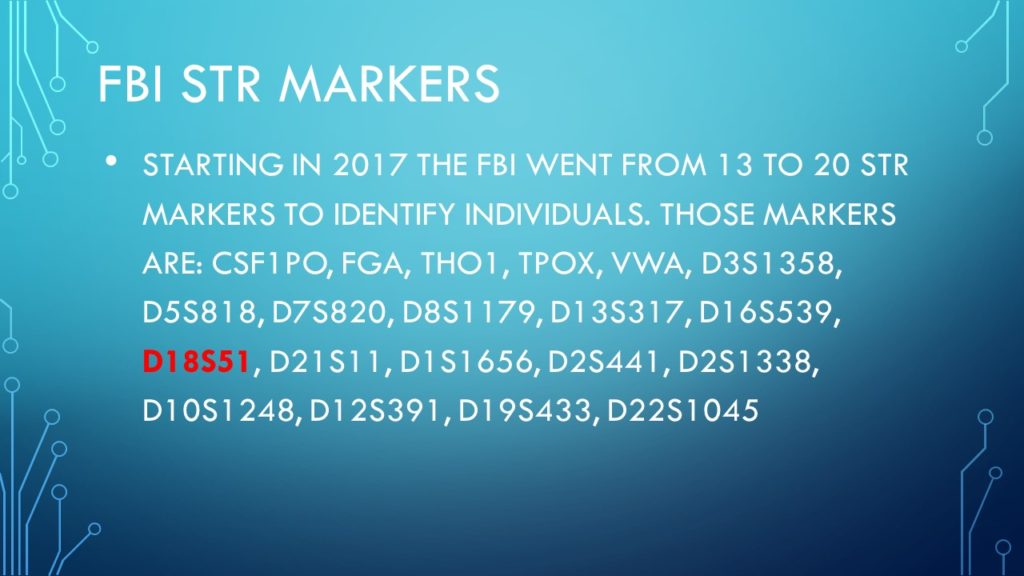
This is a list of the markers used by the FBI. Lets look at one of them – D18S51.
Slide 19

D18s51 info is here:https://strbase.nist.gov/str_D18S51.htm
Slide 20
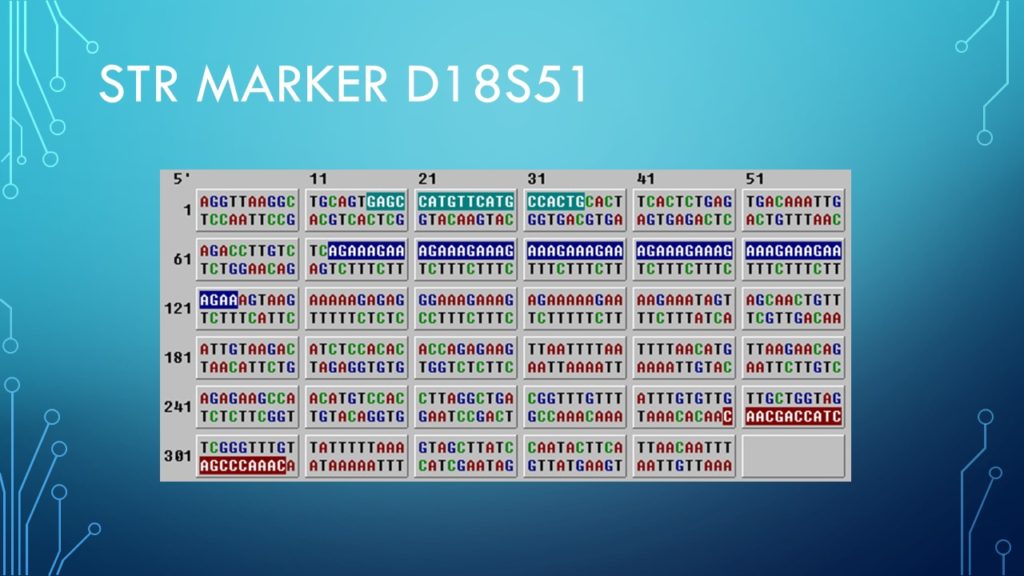
This is a graphic representation on how the base pairs repeat for that marker.
Slide 21

For a list of the y-DNA markers go here:
https://lowensteyn.com/HaploGroup/Y-STR%20VALUES.pdf
https://en.wikipedia.org/wiki/List_of_Y-STR_markers
Slide 22

So if you purchased a 37 marker test, your y-DNA is examined at 37 different locations for the specific repeating base pairs associated with that marker. Your report will show how many times the repeat sequence was observed per marker.
Then when you compare your results to another male potential relative we should see a high number of markers be exactly the same. This will confirm that you are related.
Slide 23
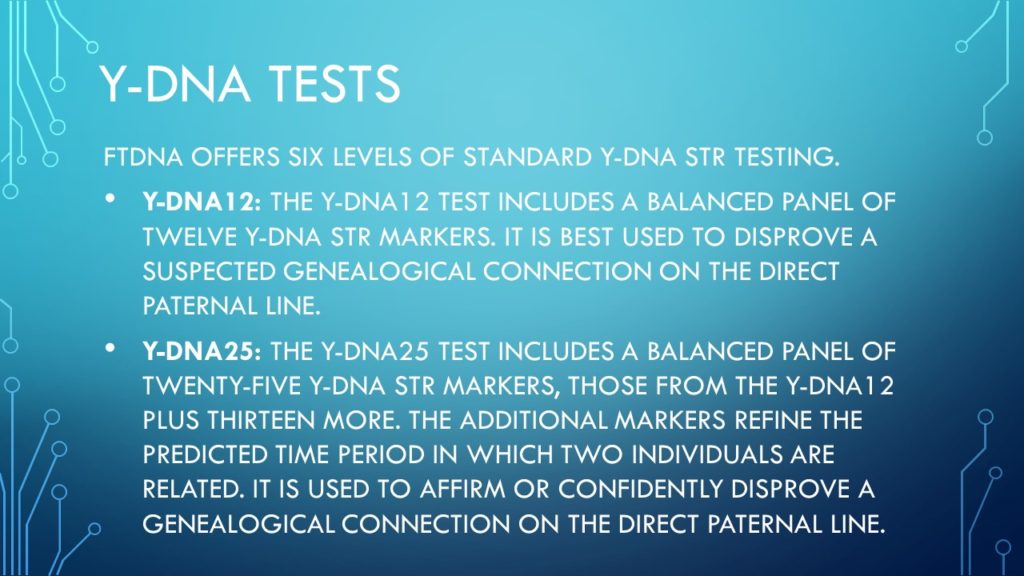
These two tests might not be offered through all testing companies. y-DNA 37 seems to be the baseline now.
Slide 24
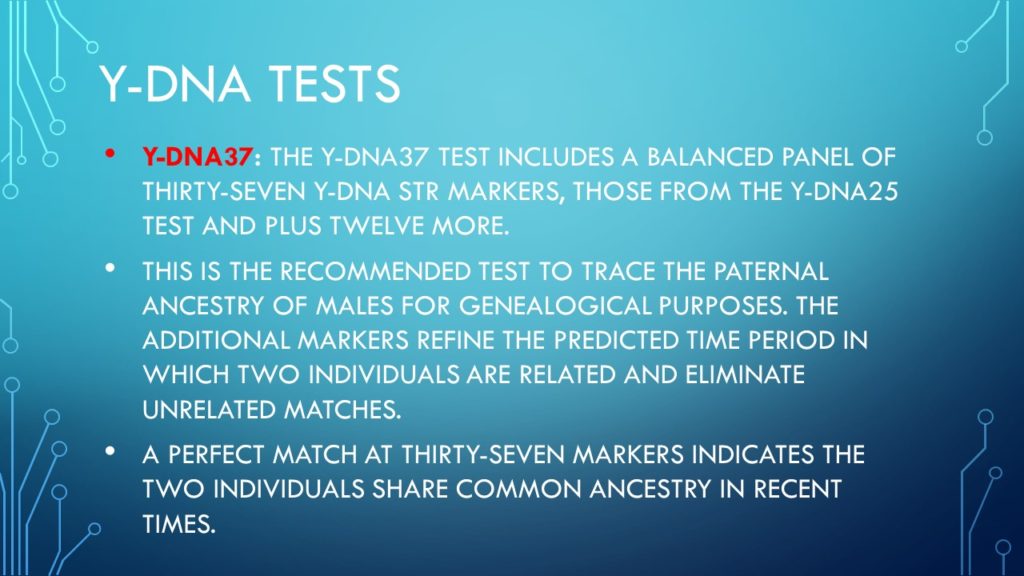
This usually is the test most people start with. If you compare your results with someone that has taken the 12 or 25 marker tests, you can only compare the markers they have had tested in common with you.
Slide 25
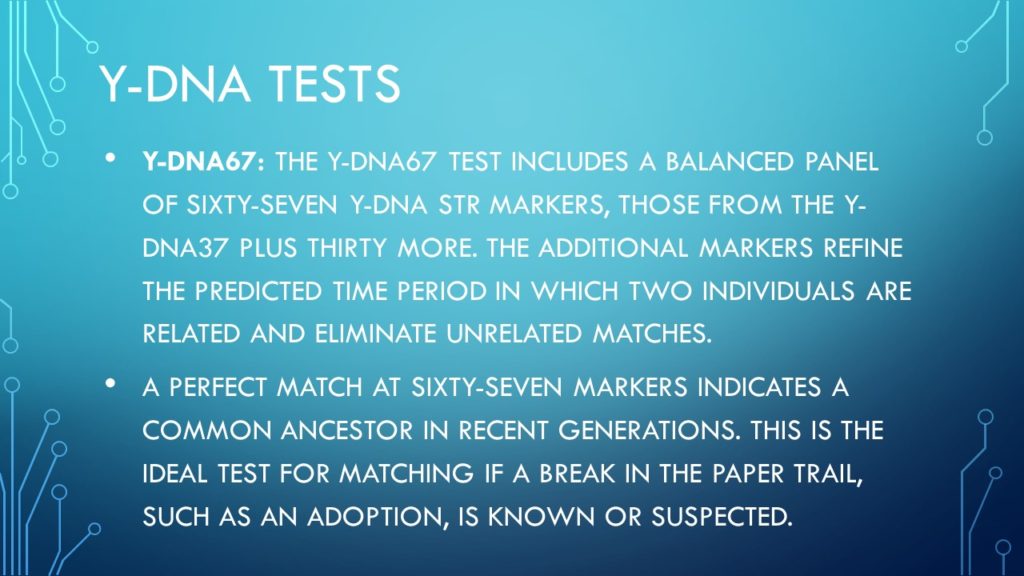
FTDNA has a webpage to explain which test might be right for you: https://www.familytreedna.com/faq-markers.aspx
Slide 26
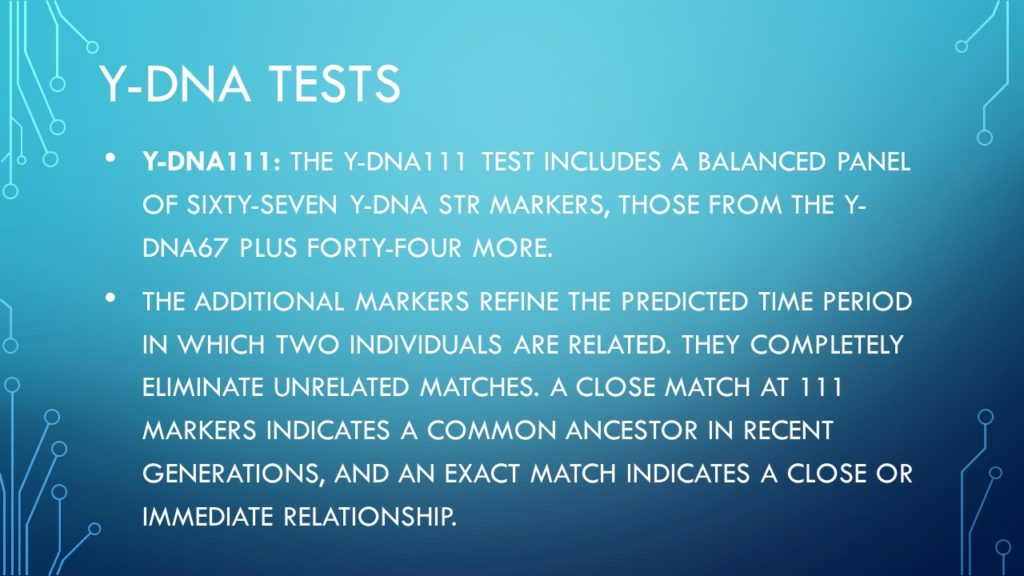
Most people start with the 37 marker test and upgrade if they need to. This currently is the highest number of markers tested.
Slide 27
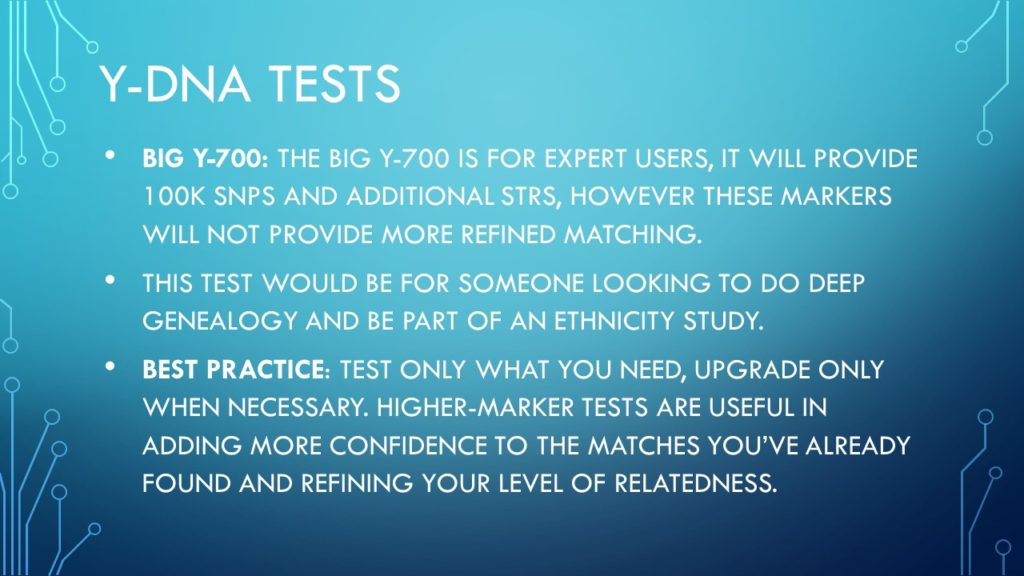
This test would be useful if you are interested in ethnic studies.
Slide 28
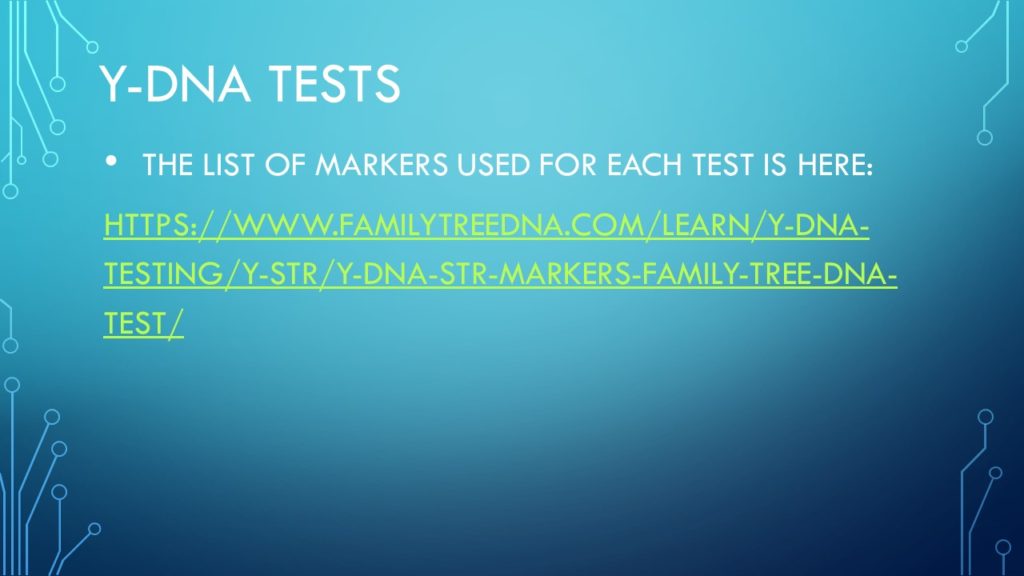
The list of markers used for each test is here:https://www.familytreedna.com/learn/y-dna-testing/y-str/y-dna-str-markers-family-tree-dna-test/
Slide 29

This slide shows that if you did a 12 marker test and compared your results to someone else’s results and got 12 out of 12 markers that matched then there is a 50% probability that you are related within 7 generations. It also means you have a 90% probability you are related within 23 generations and a 99% probability that you are related within 29 generations.
Notice the test doesn’t tell you who it is that you have in common with that person.
Notice if you test more markers the numbers get more accurate. Also notice the less markers you have in common lowers the probability %.
Slide 30
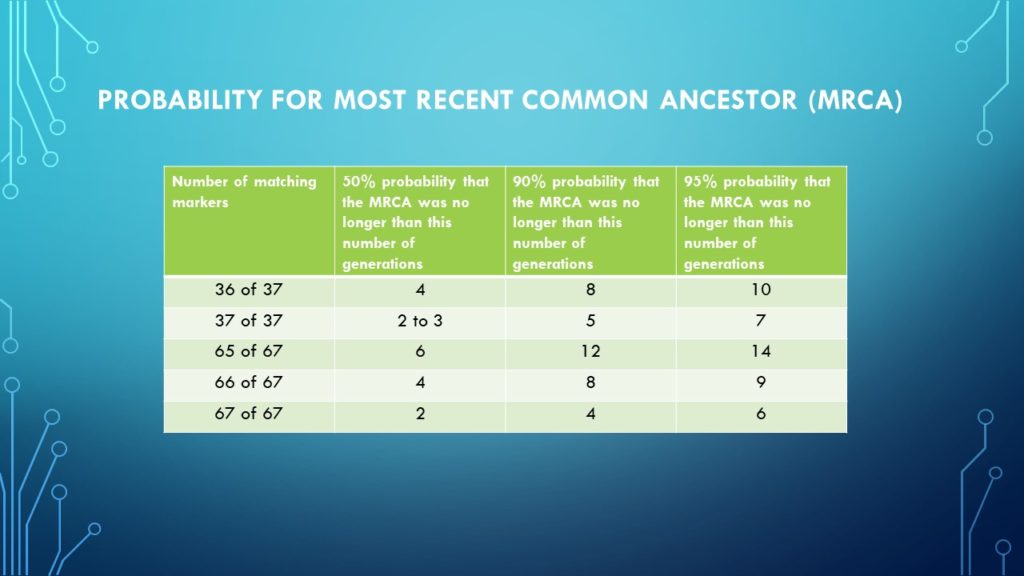
Spend more money, test more markers and get more accurate results. That’s how y-DNA works.
Slide 31
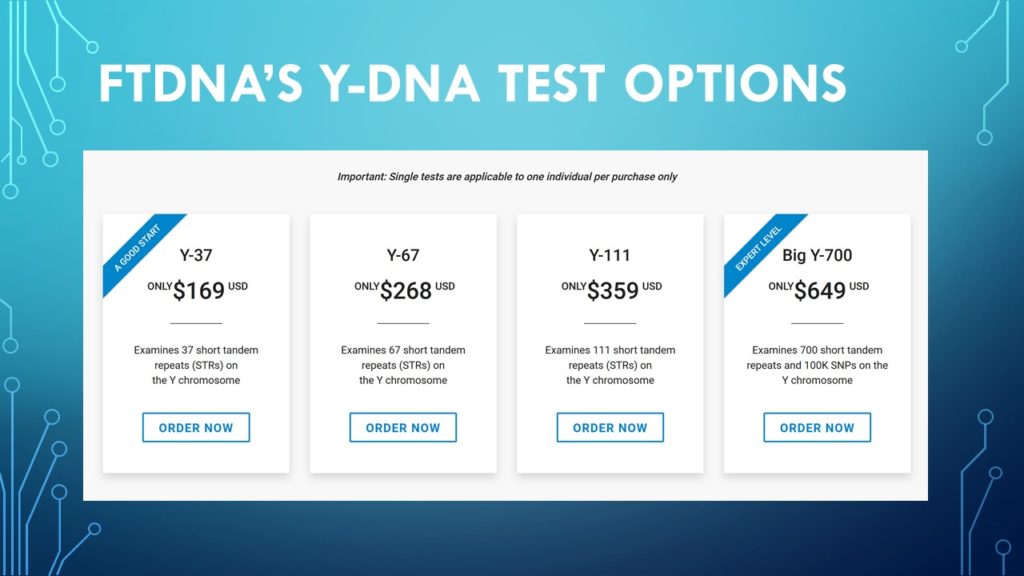
At the time of this writing these were the prices. They run sales all of the time.
Slide 32
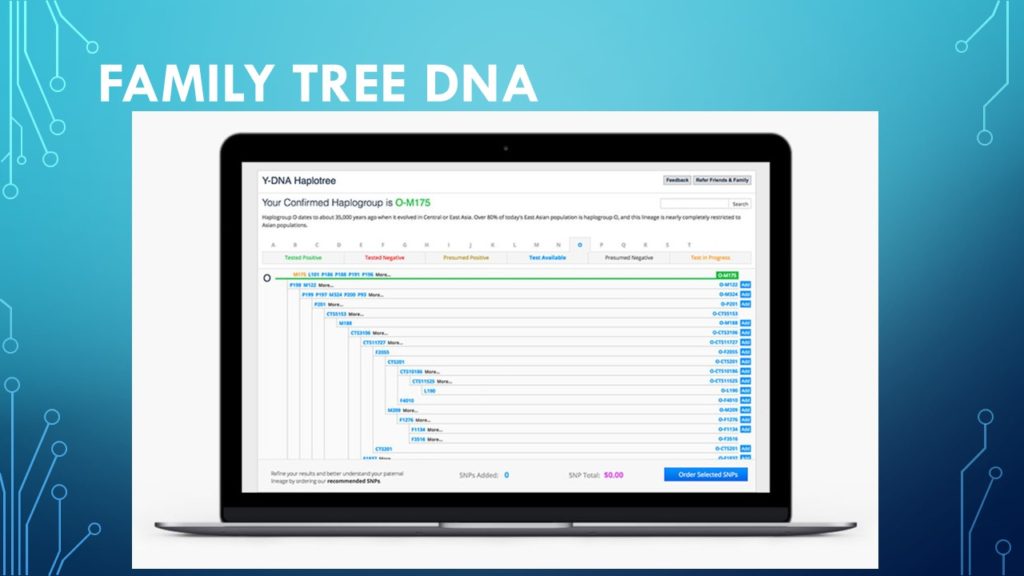
FTDNA has a number of tools to help you connect with others that have tested there.
Slide 33
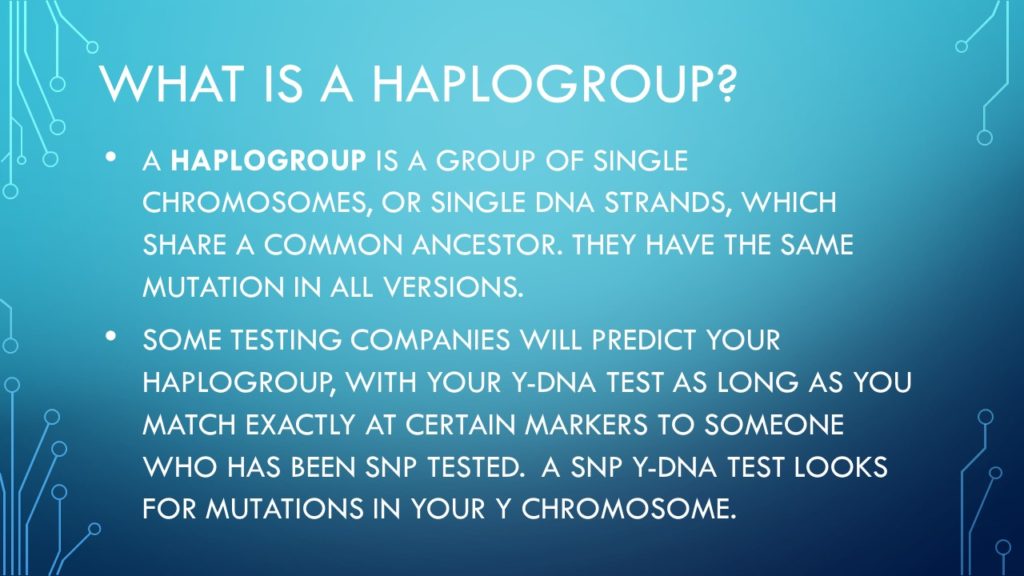
Geneticists have discovered that people whit the same markers tend to combinations of the same markers. Other types of tests can be done on the y-DNA to identify the Haplogroup.
Slide 34

You can search for people with your same Haplogroup and this could signify that you have common very distant ancestors.
Slide 35
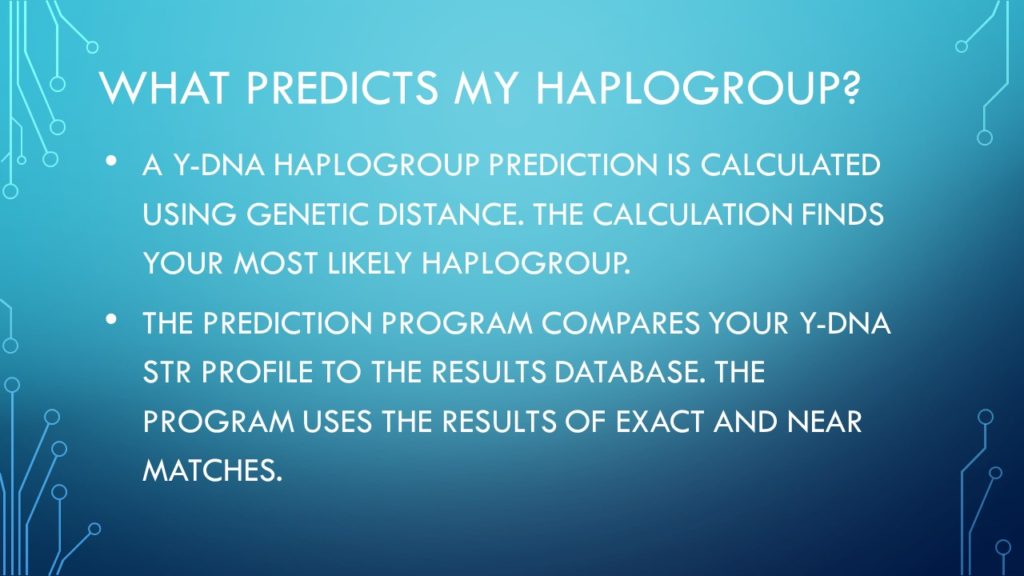
This “science” is changing all of the time. If you find it interesting then you should learn more about it.
Slide 36
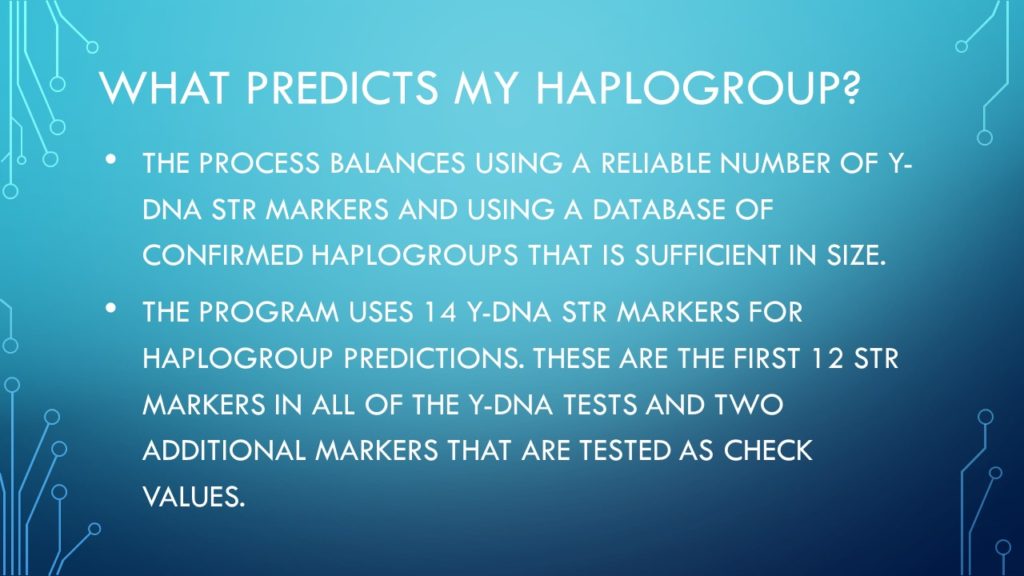
As more men get tested the worldwide Haplogroup database is growing.
Slide 37
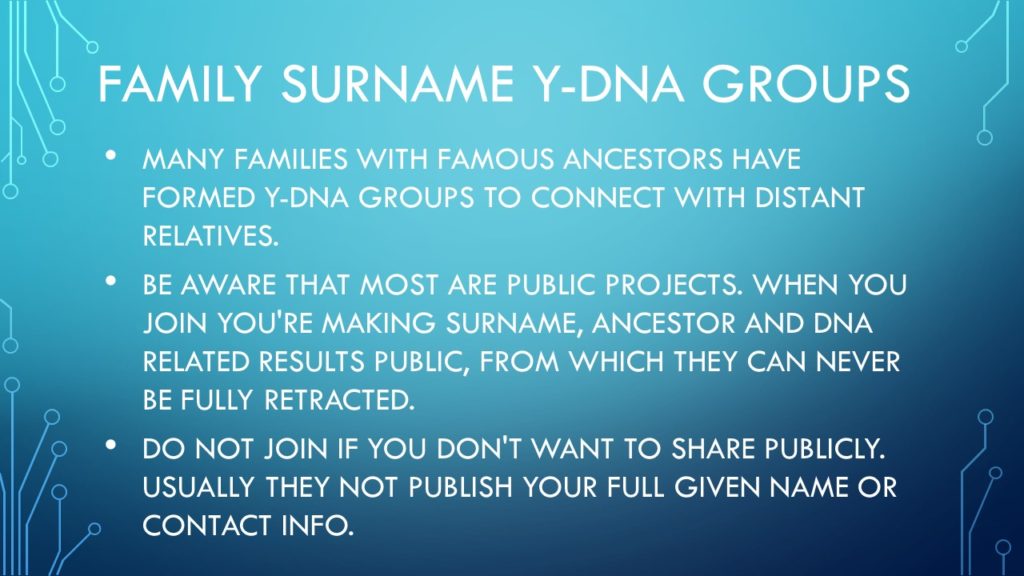
y-DNA groups are a great way to connect with possible relatives.
Slide 38
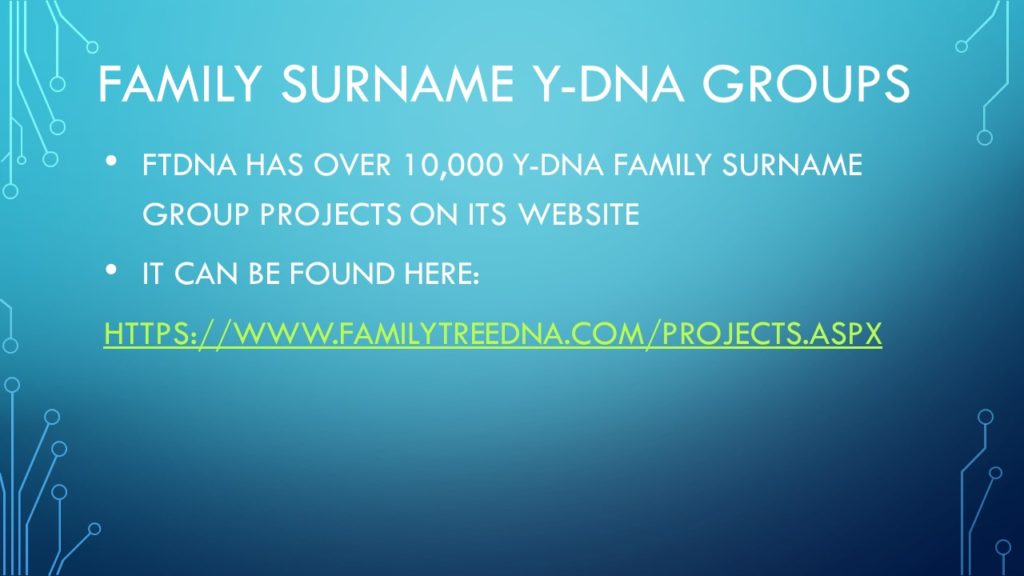
FTDNA has over 10,000 y-DNA family surname group project: https://www.familytreedna.com/projects.aspx
Slide 39
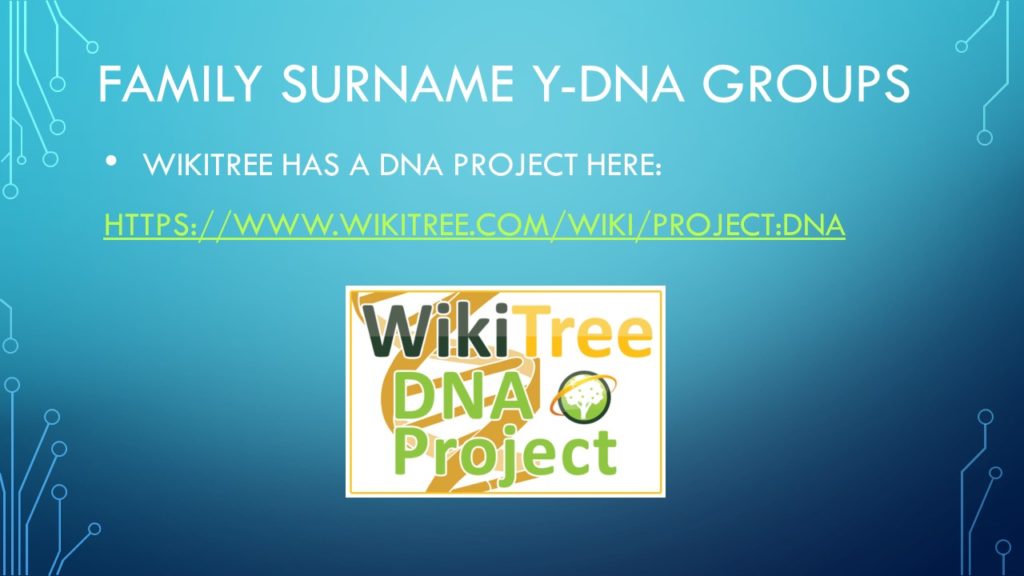
Wikitree has a dna project here: https://www.wikitree.com/wiki/Project:DNA
Slide 40

When three people have the same number of markers and the same ancestor then you have y-DNA triangulation.
Slide 41
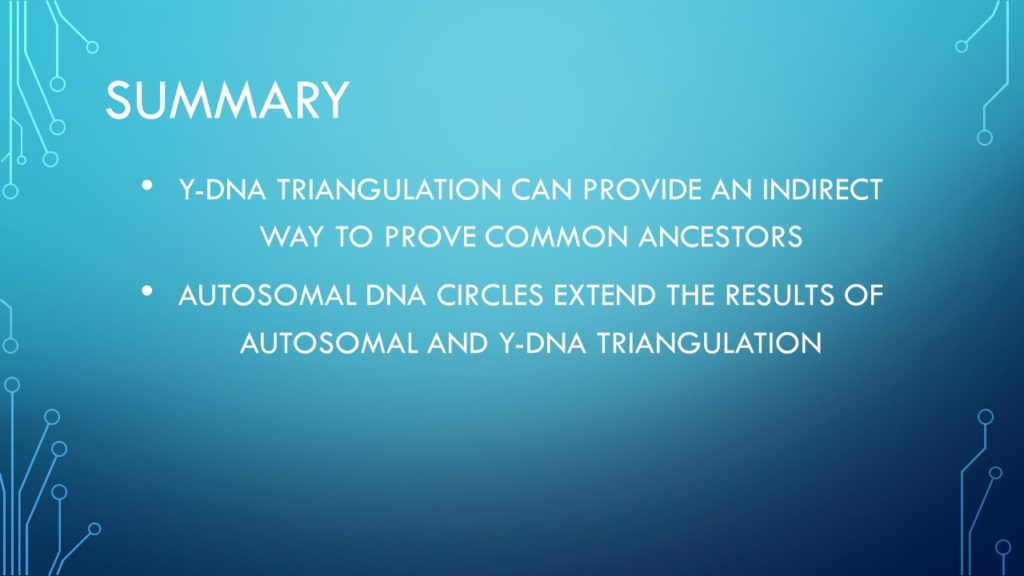
I hope that this presentation has cleared up for you (in a general way) how y-DNA works, what the test can do for us and how to use some online tools to aid you in your family tree research.
At the very least you will find thousands of new family members to share info with.
If you have any questions or comments – please email me at: [email protected]
Slide 42
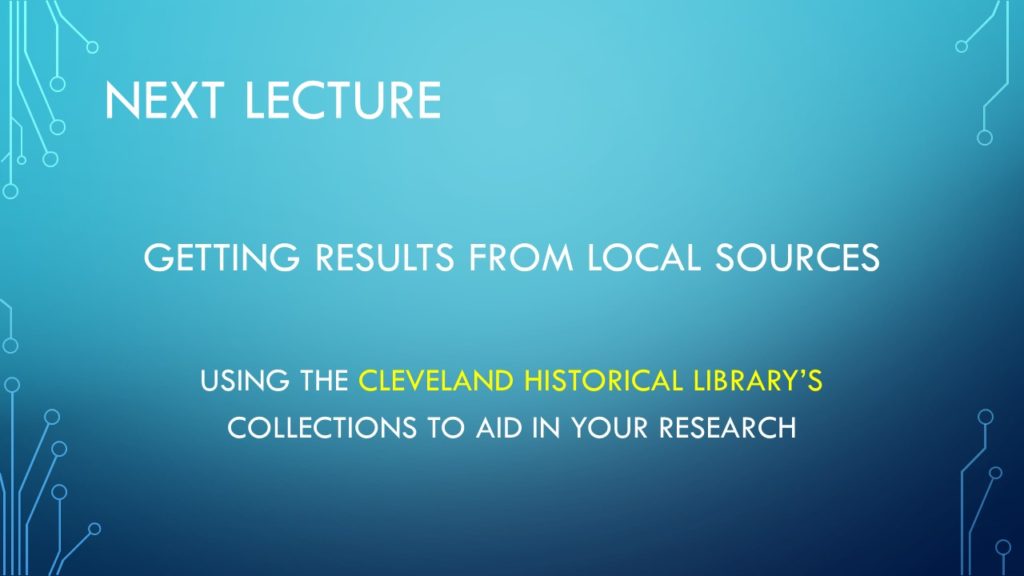
The next lecture will focus on the Cleveland Historical Society, its collections and how to use them to help you in your research.
Slide 43
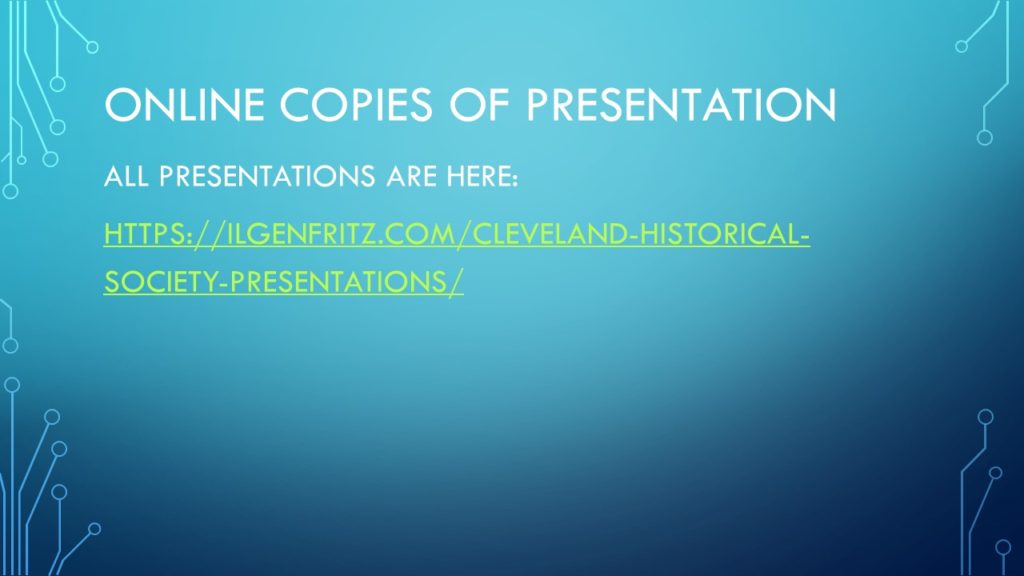
Link to other presentations HERE
Slide 44
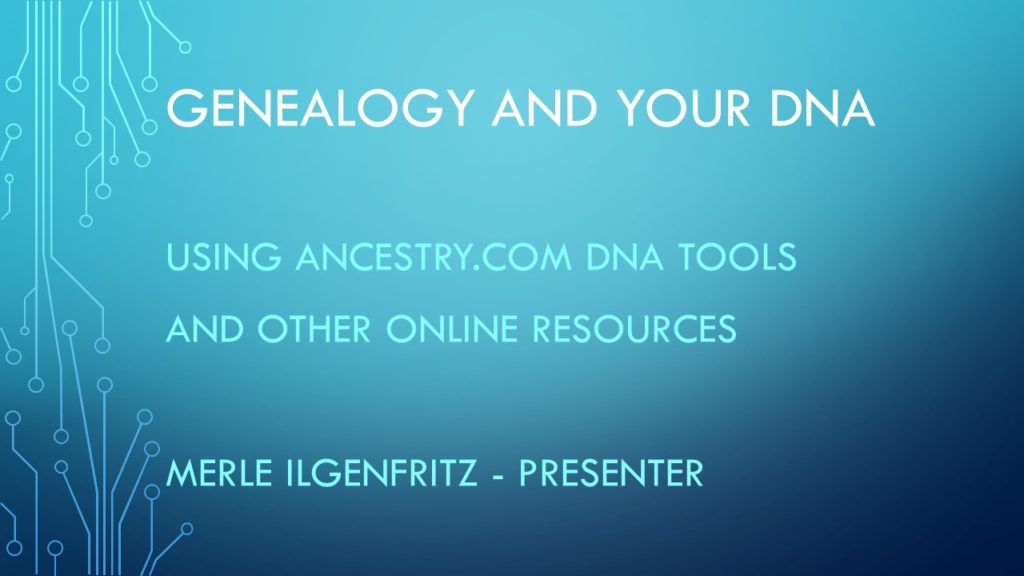
End of Presentation